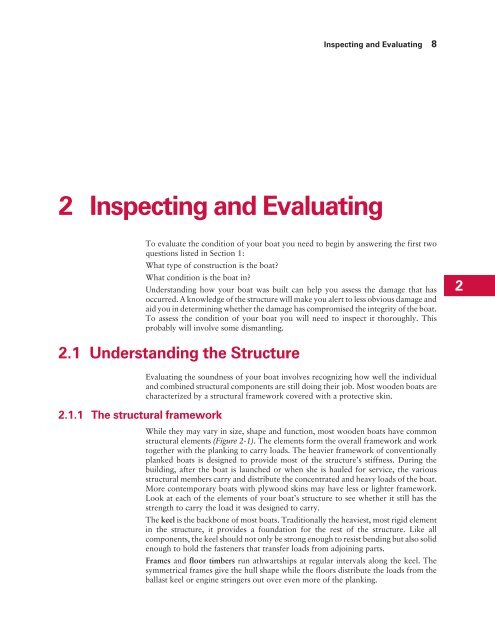Wooden Boat Restoration Repair - WEST SYSTEM Epoxy
Wooden Boat Restoration Repair - WEST SYSTEM Epoxy
Wooden Boat Restoration Repair - WEST SYSTEM Epoxy
You also want an ePaper? Increase the reach of your titles
YUMPU automatically turns print PDFs into web optimized ePapers that Google loves.
2 Inspecting and Evaluating<br />
To evaluate the condition of your boat you need to begin by answering the first two<br />
questions listed in Section 1:<br />
What type of construction is the boat?<br />
What condition is the boat in?<br />
Understanding how your boat was built can help you assess the damage that has<br />
occurred. A knowledge of the structure will make you alert to less obvious damage and<br />
aid you in determining whether the damage has compromised the integrity of the boat.<br />
To assess the condition of your boat you will need to inspect it thoroughly. This<br />
probably will involve some dismantling.<br />
2.1 Understanding the Structure<br />
2.1.1 The structural framework<br />
Inspecting and Evaluating 8<br />
Evaluating the soundness of your boat involves recognizing how well the individual<br />
and combined structural components are still doing their job. Most wooden boats are<br />
characterized by a structural framework covered with a protective skin.<br />
While they may vary in size, shape and function, most wooden boats have common<br />
structural elements (Figure 2-1). The elements form the overall framework and work<br />
together with the planking to carry loads. The heavier framework of conventionally<br />
planked boats is designed to provide most of the structure’s stiffness. During the<br />
building, after the boat is launched or when she is hauled for service, the various<br />
structural members carry and distribute the concentrated and heavy loads of the boat.<br />
More contemporary boats with plywood skins may have less or lighter framework.<br />
Look at each of the elements of your boat’s structure to see whether it still has the<br />
strength to carry the load it was designed to carry.<br />
The keel is the backbone of most boats. Traditionally the heaviest, most rigid element<br />
in the structure, it provides a foundation for the rest of the structure. Like all<br />
components, the keel should not only be strong enough to resist bending but also solid<br />
enough to hold the fasteners that transfer loads from adjoining parts.<br />
Frames and floor timbers run athwartships at regular intervals along the keel. The<br />
symmetrical frames give the hull shape while the floors distribute the loads from the<br />
ballast keel or engine stringers out over even more of the planking.<br />
2
















